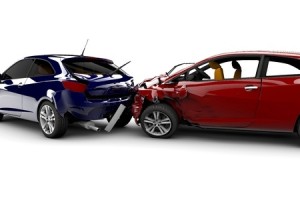
![]() Written By: Lawrence Flick
Written By: Lawrence Flick
Of all the types of car accidents, a rear end collision is probably the kind you are most likely to be involved in. As a car crash lawyer it is probably the most common car accident type that we see.
In a rear end collision, the front end of one car or other vehicle crashes into the back end of the car you are in. Frequently, the car that is hit was stopped in traffic, at a stop sign, or at a traffic light.
Rear-end collisions can differ from other kinds of car accident injuries because often the auto which is hit may be moving at a few miles per hour or is stopped. The victim may even see the oncoming car in the rear view mirror, hear squealing brakes, the sound of the vehicle behind skidding and brace themselves for impact.
Most rear-end crashes involve two vehicles. However, they can also involve more than two vehicles resulting in a multi-vehicle “chain reaction” collision. In the average three-vehicle rear-end collision, the first two vehicles are stopped when the third vehicle hits the middle vehicle causing the middle vehicle to move forward and strike the first.
In rear end crashes, the driver of the vehicle that crashes into the vehicle ahead of it is typically considered to be responsible for the wreck. Drivers of vehicles which rear end the car ahead of them will often be given tickets for violations like inattentive driving, driving too fast for conditions or following too closely.
The driver of the, car which is struck is most often not considered to be at fault. However, an experienced car accident attorney knows that there are exceptions. One example may be when a vehicle suddenly and abruptly changes lanes, putting it in front of another vehicle with very little space between them and then suddenly slams on the brakes.
Potential Causes and Prevention
 Common causes of rear end collisions are tailgating, following too closely, speeding or driving too fast for conditions and driver distraction/inattentiveness. These auto accidents can also result from excessive speeding, driving under the influence of drugs or alcohol, unsafe lane changes, poor visibility, or slippery road conditions.
Common causes of rear end collisions are tailgating, following too closely, speeding or driving too fast for conditions and driver distraction/inattentiveness. These auto accidents can also result from excessive speeding, driving under the influence of drugs or alcohol, unsafe lane changes, poor visibility, or slippery road conditions.
Some ways drivers can avoid rear ending other vehicles include maintaining proper following distance and driving at a safe and appropriate speed taking into account the speed limit and traffic conditions on the road. Consideration also needs to be given to weather and road surface conditions. Traction decreases on roads made slippery by rain, snow or ice requiring longer stopping distances. Careful driving in these circumstances requires greater following distances and appropriate adjustments to speed.
Injuries
Perhaps the most common mechanism of injury in the typical rear end collision is when force being applied by the vehicle striking the rear of your car propels vehicle occupants first forward. Then, because, under basic physics, for each action, an opposite reaction occurs, you are then thrown back. These forward and backward forces occurring quickly can injure muscles, ligaments and other structures in your back, neck and other areas. Not surprisingly, strains/sprains to muscles and ligaments in the back and neck are probably the signature injury caused by rear end collisions. These are sometimes referred to as “soft tissue injuries” or “whiplash”. Bulging discs, herniated discs, brain injury and, fortunately less often, spinal cord injury are some of the other kinds of injuries which rear end car accidents can cause.One of the really interesting and somewhat surprising things about rear end collision injuries, and in fact many kind of car wrecks is that the people in the car, despite having been exposed to the same forces, may have very different injury kinds and severities. Injuries may range from some vehicle occupants having severe injuries, or even being killed, to others having none.
Insurance Company Tactics
 Because rear end collisions are so common, car insurance companies handle lots of them. Their claims adjusters and attorneys are typically very experienced with them and have a well-developed set of procedures for dealing with them.
Because rear end collisions are so common, car insurance companies handle lots of them. Their claims adjusters and attorneys are typically very experienced with them and have a well-developed set of procedures for dealing with them.
One common insurance company tactic is to categorize your case, in insurance language, as a “minor impact soft tissue” or MIST case. These are typically cases where there is relatively minor physical damage to one or both vehicles. The car insurance company may then question how you could have been hurt with such minor damage to the vehicles involved.
Another common approach is to label your injuries “subjective”. This means basically that proof of your injuries depends heavily on your complaints and they are not documented by x-rays, MRIs or other medical imaging tests.
At Flick Law Firm we have been recovering money for people injured in automobile accidents since 1993 and have repeatedly dealt with these and other insurance company tactics. Contact us today to see how we can help with your case.




